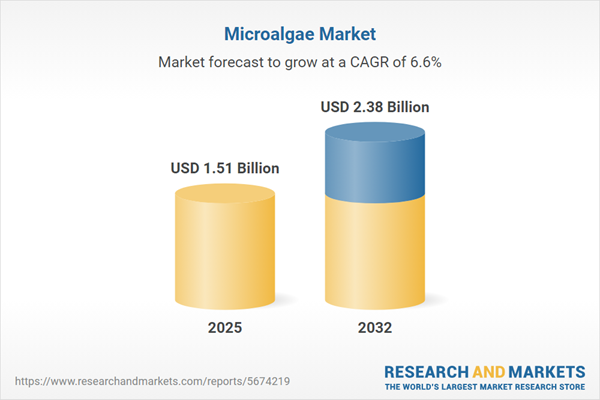Speak directly to the analyst to clarify any post sales queries you may have.
The microalgae market is quickly becoming integral to biotechnology, driven by advancements in cultivation, shifting consumer preferences, and increased regulatory scrutiny. As industries seek circular solutions and sustainable raw materials, microalgae provides diverse applications and strategic potential.
Microalgae Market Snapshot
The global microalgae market grew from USD 1.43 billion in 2024 to USD 1.51 billion in 2025, and is projected to reach USD 2.38 billion by 2032, reflecting a steady CAGR of 6.57%. This growth reflects accelerating commercial adoption, sectoral investment, and robust expansion across end-use industries.
Scope & Segmentation
This report provides comprehensive coverage of the microalgae industry by examining major growth drivers, technology trends, and emerging opportunities. Market segmentation includes:
- Product Forms: Extracts, oils, and powders, each tailored to unique functional and application requirements.
- Species: Chlorella, Diatoms, Dunaliella Salina, Haematococcus Pluvialis, Spirulina, covering a broad spectrum of nutritional and industrial uses.
- Cultivation Methods: Closed photobioreactors, fermenters, and open ponds, selected according to capital needs, contamination management, and productivity goals.
- Applications: Ranging from animal feed, biofuels, and bioremediation to cosmetics, food and beverage, and nutraceutical/pharmaceutical industries.
- Distribution Channels: Distributors (direct sales, retail, wholesale) and digital platforms (company websites, e-commerce), facilitating both B2B and direct-to-consumer engagement.
- Key Regions: Americas (including North and Latin America), Europe, Middle East and Africa, and Asia-Pacific—with country-level insights identifying regional strengths and innovation dynamics.
- Technological Themes: Adoption of closed system cultivation, use of precision fermentation, process automation, digital monitoring, and integration of sustainability-focused solutions.
- Company Coverage: Analysis includes AlgaeCytes Limited, AlgaEnergy, Algatech Ltd., Allmicroalgae Natural Products S.A., BASF SE, Cargill Incorporated, and other leading players driving sectoral innovation.
Key Takeaways for Senior Decision-Makers
- Microalgae is transitioning from experimental stages to large-scale commercial operations, leveraging innovation in photobioreactor designs and fermentation technologies.
- Partnerships among academia, industry, and policy bodies are accelerating the conversion of research into application-ready products in high-value markets.
- Biodiversity and strain optimization are central to addressing broader demands in protein, pigment, lipid, and specialty ingredient markets across both established and emerging segments.
- Regulatory policies promoting sustainability and eco-labeling continue to open new channels, while biosecurity harmonization supports cross-border trade and fosters market expansion.
- Varied regional dynamics—including scalable production in Asia-Pacific, low-cost cultivation in Latin America, and EU regulatory support—present distinct operational and investment environments for global participants.
Tariff Impact on Competitive Positioning
Recent tariffs on microalgae imports in the United States are prompting a fundamental reassessment of sourcing, supply chain configuration, and production geography. Importers and international producers are exploring local partnerships and distributed manufacturing to manage procurement costs and navigate downstream pricing sensitivity, which is reshaping competitive strategies and incentivizing vertical integration.
Methodology & Data Sources
This analysis draws on a blend of primary and secondary research. Industry interviews, end-user surveys, and expert workshops inform scenario planning and segment prioritization. Secondary reviews encompass scientific literature, regulatory filings, and public company disclosures. Data is validated through rigorous cross-referencing and iterative review processes.
Why This Report Matters
- Informs investment and operational decisions by mapping pivotal trends, technologies, and regional growth hotspots across the microalgae value chain.
- De-risks market entry and expansion by delivering granular risk assessments and supply chain insights relevant for strategic planning.
- Guides executive teams in adapting to regulatory, technological, and geopolitical shifts affecting long-term market positioning.
Conclusion
The microalgae market presents expanding opportunities across biotechnology, sustainability, and nutrition-driven sectors. Leaders that collaborate, innovate, and align with regulatory and market dynamics will best position their organizations for enduring growth in this evolving landscape.
Additional Product Information:
- Purchase of this report includes 1 year online access with quarterly updates.
- This report can be updated on request. Please contact our Customer Experience team using the Ask a Question widget on our website.
Table of Contents
3. Executive Summary
4. Market Overview
7. Cumulative Impact of Artificial Intelligence 2025
Companies Mentioned
The companies profiled in this Microalgae market report include:- AlgaeCytes Limited
- AlgaEnergy
- Algatech Ltd.
- Algiecel ApS
- Allmicroalgae Natural Products S.A.
- Aralab
- Archer Daniels Midland Company
- BASF SE
- Brevel Ltd.
- Cargill, Incorporated
- Cellana Inc.
- Checkerspot, Inc.
- Cyanotech Corporation
- DIC Corporation
- Far East Microalgae Industries, Co., Ltd.
- Kuehnle AgroSystems Inc.
- Phycom BV
- Plankton Australia Pty Limited
- Seagrass Tech Private Limited
- Solabia Nutrition
- Solazyme, Inc.
- Sun Chlorella Corporation
- Taiwan Chlorella Manufacturing Company
- Taiwan Wilson Enterprise Inc.
- Valensa International
- Vedan Biotechnology Corporation
Table Information
| Report Attribute | Details |
|---|---|
| No. of Pages | 180 |
| Published | November 2025 |
| Forecast Period | 2025 - 2032 |
| Estimated Market Value ( USD | $ 1.51 Billion |
| Forecasted Market Value ( USD | $ 2.38 Billion |
| Compound Annual Growth Rate | 6.5% |
| Regions Covered | Global |
| No. of Companies Mentioned | 27 |









